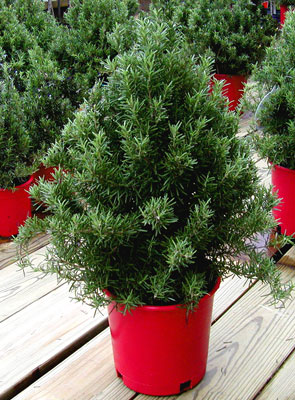Rosemary
Rosmarinus officinalis

. . . for an herbal Christmas tree or garden topiary
Common Name: Rosemary
Botanical Name: Rosmarinus officinalis
Design Plan: Decorate a tabletop rosemary with a string of mini lights and bow-shaped pasta, either spray-painted or au naturel and tied on with jute or thin ribbon. Add traditional mini ornaments or create a natural theme by garnishing with nuts, acorns, berries and small fruit such as crabapples, kumquats and grapes. In the garden, use sculpted topiaries to flank an entrance or as centerpieces in formal designs.
Light: Potted gift plants clipped into Christmas tree shapes or balled topiaries can live indoors temporarily, but will require more light than most home situations to survive long-term. Keep potted plants near window or on a freeze-protected porch when not serving as tabletop décor. Keep the plant outdoors during the growing season, either potted or set into the ground. Outdoors-grown plants take full sun or partial shade.
Water: Potted plants require constantly moist soil, while matured plants growing in flowerbeds become more drought tolerant; excellent drainage is crucial in both situations. Transplanting a root-bound potted plant into a larger pot will reduce frequent watering requirements. The conifer-like leaves do not wilt to warn when the plant is about to die from lack of water. To keep pot soil consistently moist, soak in sink full of water at least once a week and allow it to drain thoroughly after each soaking.
Size and Grooming: Balled and cone-shaped rosemary topiaries can be trimmed with scissors or hedge clippers in the spring and fall to maintain the sculpted form. Hedge type clipping will instigate an upright, dense frame of branches and more height than a non-clipped version. Without clipping, matured branches of upright forms arch downwards to maintain a 3-4 foot tall mound.
Flowers: Light blue flowers occur on matured stem tips in early winter or spring.
Cold Tolerance: Hardiness varies among the varieties, but healthy mature plants growing in the ground are tolerant of frost and light freezes. The Texas-found variety of R. officinalis 'Arp' survives –10 degrees F.
Snippets: Besides the upright form described above, there are also creeping prostrate varieties. Use leaves to season savory dishes and throw the stems on hot coals in the grill or fireplace to emit the rosemary aroma. Strew extra trimmings on doormats for foot-traffic fragrance.

Cultivated, photographed and written by
Maggie Ross McNeely in Fort Worth, Texas
All rights reserved